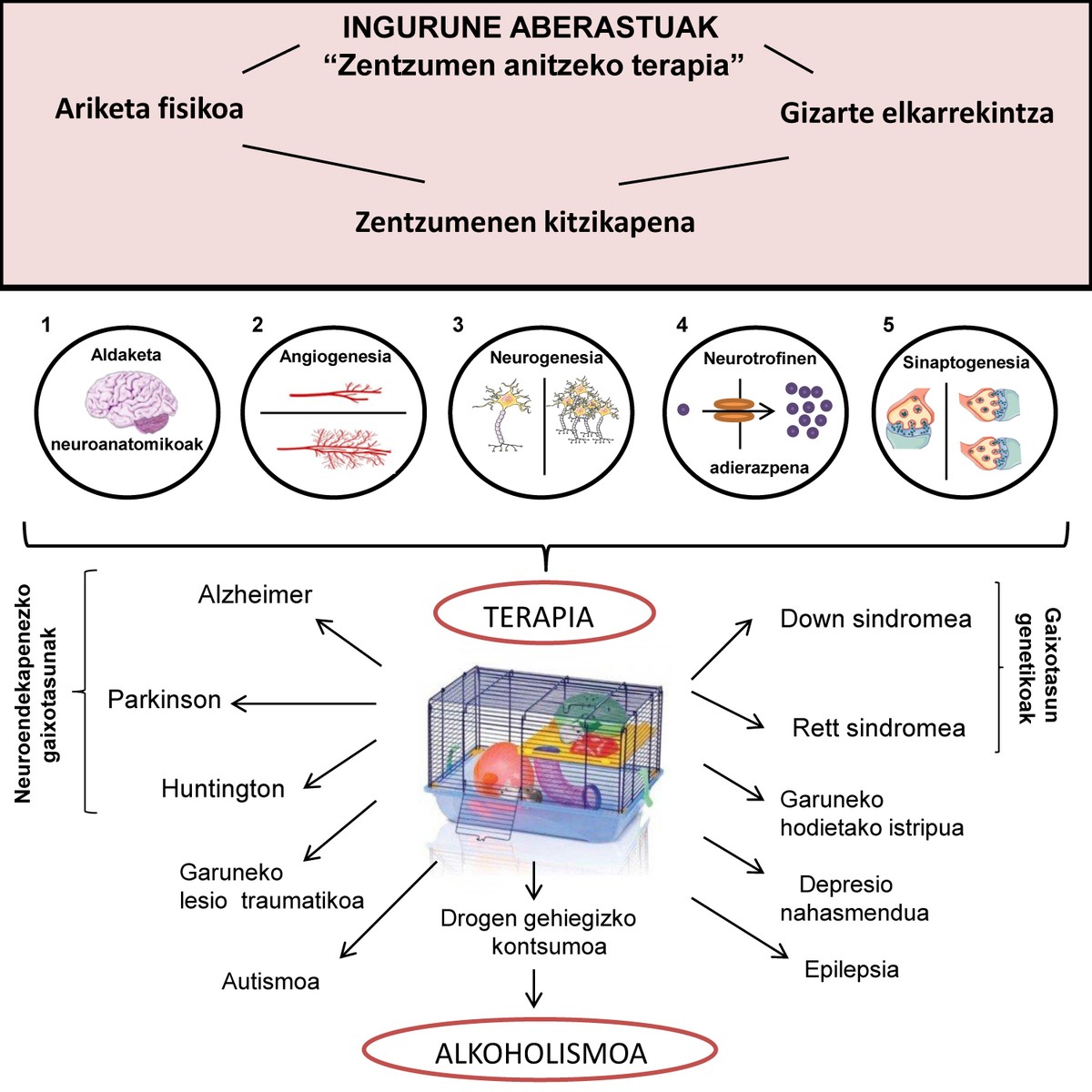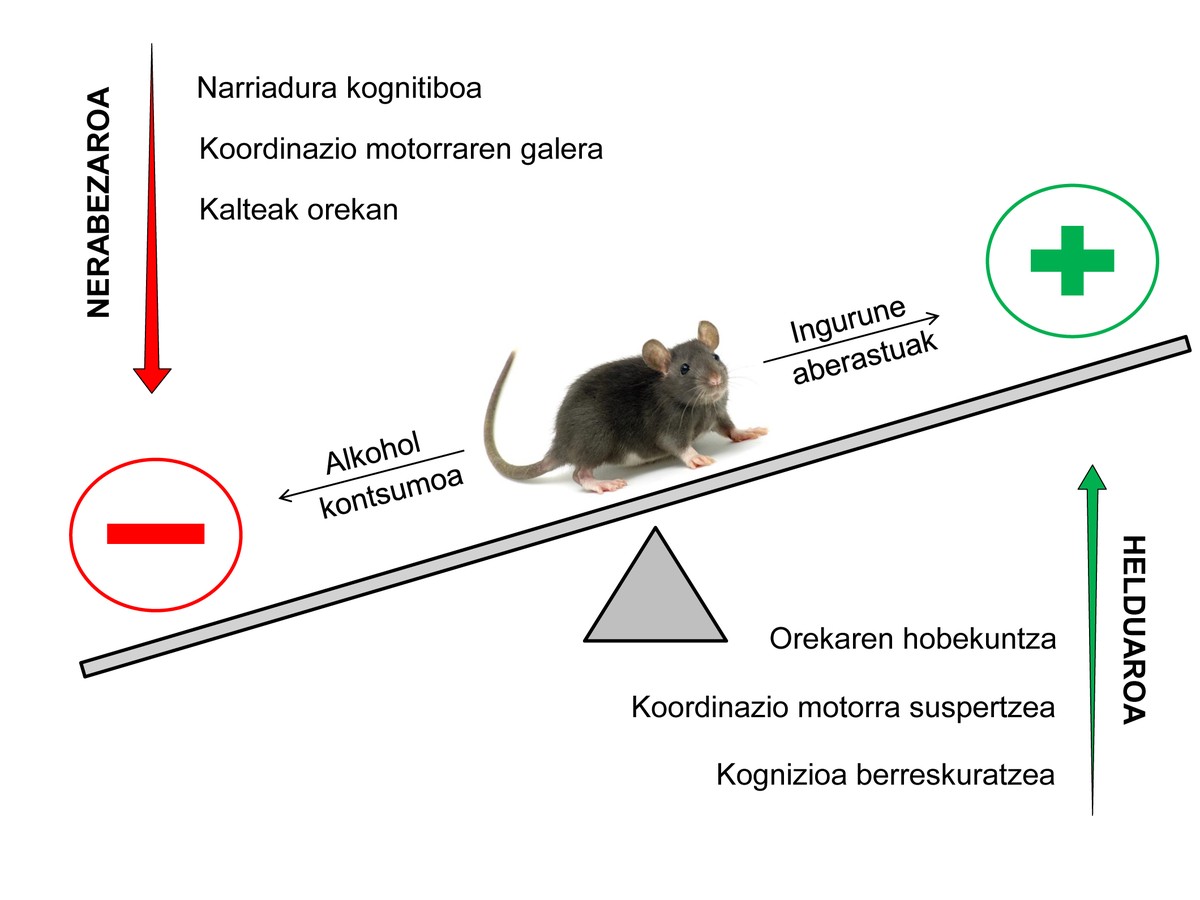Treasure of multi-sensory therapy
2018/08/02 Irantzu Rico Barrio - Medikuntza eta Erizaintzako irakaslea eta Neurozientziak Saileko ikertzailea, EHU Iturria: Elhuyar aldizkaria
The enriched medium is a combination of objects, social interaction and physical exercise. In 1947 the Canadian psychologist Donald Hebb described for the first time the benefits of these environments. To do this, he took to explore the banks of his residence half of a rat breeding that was growing in the usual laboratory cages. Rats, like domestic animals, traveled freely, from one side to the other studying, exploring, exciting exponentially their senses. Subsequently, Hebb performed behavioral tests in memory, and realized that the rats that lived free in his home significantly and better exceeded the results of the behavioral tests of the rats cultivated in the cages of the traditional laboratory. Then the revolution of research began in enriched environments.
Since then, many investigations have been carried out. The use of enriched media produces anatomical alterations, among which an increase in the weight, thickness and size of the crust has been described, as well as an increase in the volume of the anatomical zone related to the learning capacity and memory processes, the hippocampus. In addition to promoting the development and excitation of the senses, it promotes creative processes such as angiogenesis (formation of new blood vessels from the already existing ones) synaptogenesis (formation of synapses), neurogenesis (production of neurons) and the expression and release of neurotrophic factors (figure 1). In addition, it has been shown to reduce the process of apoptosis (programmed cell death). Since the finding of all these processes, enriched environments have become a powerful, valuable and precious tool, which has been proposed and used as multi-sensory therapy in various diseases to improve the quality of life of patients.
To combat the disease... Enrich it!
Studies of recent decades have shown and confirmed that these unique environments are very beneficial and healthy. In the case of Alzheimer's disease, multi-sensory therapy causes a significant decrease in amyloid accumulation (Abs), which has been directly related to an expressive cognitive improvement of mice. In addition, this therapy increases resistance to the neurotoxic compound MPTP that causes Parkinson. In the disease known as Hungtinton, the enriched medium restores the scarcity of proteins that occur as a result of the disease and thus alleviates the lack of motor coordination that the disease causes in mice. But the benefits of this therapy have not only been detected in neurodegenerative diseases. In autism, stroke, traumatic brain injury, epilepsy, depression, and many genetic diseases have also seen healthy effects.

On the other hand, it should be noted that these special conditions can have very beneficial effects in cases of substance dependence and against abusive drug use. The novelty, the physical exercise and the social interaction offered by the enriched medium make the brain circuits of rewards are activated repeatedly and, consequently, the compulsive self-management of psychostimulants substances so characteristic of drug addiction is reduced. In addition, there is a decrease in vulnerability to rat drugs. For this reason, multi-sensory therapy has become a leading activity to combat drug addiction, as well as preventive measures and treatment (Figure 1).
Alcohol: from leisure to death
Celebrations, dinners of txokos, festivals, parties, family meals… In Basque culture, alcohol consumption is very rooted, it is a normalized custom. However, according to the World Health Organization, alcohol (above cocaine, synthetic stimulants, hallucinogens or cannabis derivatives) is the most dangerous drug for the physical, mental and social health of people. On the one hand, it can cause short-term risks, such as car accidents, coma by ethyl poisoning or sudden death. It also has less known long-term organic and psychological effects. In fact, the risk of suffering these damage increases when consumption begins in adolescence, where a continuous process of brain development and maturation occurs.
For a couple of years, researchers from the UPV-EHU Neuroscience Laboratory have been investigating the long-term adverse effects that occur from excessive alcohol consumption in adolescence. In this research project carried out with the mice, a model equivalent to the street drink that young people carry out every weekend was used, that is, an alcohol consumption based on short-term arrears.
According to the results observed in this study, the harmful effects of alcohol remain long-term. This is especially perceived when behavioral tests are performed in memory. Mice immersed in the model of street drink in adolescence have shown worse memories of recognition and association by comparing them with control groups. In this sense, the loss of space memory has also been evident, reflecting a significant cognitive decline. In addition, mice who drink alcohol in adolescence have a motor coordination and a worse balance.
In view of these results, our group proposed to take a further step: to analyze the beneficial effects that therapy in enriched medium could have on the recovery of brain lesions that occurred in mice as a result of excessive alcohol consumption.
Enriched medium as treatment of alcoholism
Mice immersed in the model of the street drink were introduced for two weeks in half-enriched cages. They are larger than conventional laboratory cages, with running wheels, slopes, tunnels and objects of different colors, sizes and textures to excite the senses of animals and promote physical exercise and social interaction, thus ensuring the molecular, anatomical and functional changes of the brain development process.
The results were very illustrative, as they showed that the quality of life of people living or living under the drink could be improved. On the one hand, these special conditions completely restored the cognitive deterioration, by completely reestablishing spatial memory, memories of knowledge and association, and at the same time stimulating the motor coordination and shaping the balance (Figure 2).

The treasure of the senses, from basic research to the health system
From the moment we are born we are mortal living beings and, as if we were playing inside a giant Russian roulette, we wait for our lipar to predict what “bullet” or disease has touched us when we hit the cat at the height of the local. Neurodegenerative disease, cancer, infarction, apika?
The enriched media acts as a security closure of this gun delaying the symptoms of this disease or “bullet”. The immediate health consequences of Snoezel's therapy are already known, a multi-sensory therapy based on relaxation and personal well-being, created in the Netherlands in the 1970s. Over the years, the benefits of this new concept were fully accepted in northern European countries such as Canada, Australia or the United States. However, until the 1990s, the therapeutic use of this technique was not shown, especially among people with mental disabilities and dementia.
Today, however, we have more access to the therapy in enriched environment, which has already been launched in Euskal Herria, since the first center of attention was opened in Donostia in 2011. The aim of this center is to check whether the novelty offered by this therapy model fits the needs of the population, offering cognitive-sensory therapies to children and adults with disabilities, among others.
Thus, an optimistic perspective is perceived to improve the quality of life of people who have lived under alcoholism. In fact, taking into account the prevalence rate of excessive consumption of alcohol in minors and the losses that this excessive consumption causes especially in adolescence, both the health system and citizenship have unanimously requested the investigation of prevention projects or new treatments. However, it is often difficult to achieve the objective of these prevention programs. In the Basque culture in particular, in which the elevation and rigidity of elbow is considered Olympic sport.
The fact that alcohol consumption is socially normalized and, above all, historically, is rooted in the culture of leisure, obliges us to maintain the balance between leisure and alcohol consumption. And the road is simple, it is feasible. We live in a natural, sustainable and unconscious enriched environment. The exploitation and exploitation of this resource, which is in its power. Taste, touch, sight, smell and ear. Five senses. A treasure.
Thanks to Izaskun Elezgarai, a teacher who knows how to get the best out of the researchers.
Bibliography Bibliography Bibliography
Bennett, EL. ; Rosenzweig, MR.; Diamond, MC. : “Rat brain: effects of environmental enrichment on wet and dry weights”. Science, 163 (1969), 825-826.
Berardi, N.; Braschi, C.; Capsoni, S.; Cattaneo. A.; Maffei. L.: “Environmental enrichment delays the onset of memory deficits and reduces neuropathological hallmarks in a mouse model of Alzheimer-like neurodegeneration”. J. Alzheimers Dis, 11 (2007) 359-370.
Birch, AM. ; McGarry, NB. ; Kelly, AM. : Poor environmental enrichment, in the absence of exercise, improves memory, and increases NGF concentration, early neuronal survival, and synaptogenesis in the dentate gyrus in a time-dependent manner. Hippocampus, 23 (2013), 437-450.
Chen, X.; Zhang, X.; Xue, L.; Hao, C.; Liao, W.; Wan, Q.: “Treatment with Enriched Environment Reduce Neuronal Apoptosis in the Periinfarct Cortex after Cerebral Ischemia/Revfusion Injury”. Cell Physiol Biochem, 41 (2017), 1445-1456.
Diamond, MC. ; Ingham, CA. ; Johnson, RE. ; Bennett, EL. ; Rosenzweig, MR.: “Effects of environment on morphology of cerebral rat cortex and hippocampus”. J Neurobiol, 7 (1976), 75-85.
Fares, RP. ; Belmeguenai, A.; Sánchez, PE. ; Kouchi, HY. ; Bodennec, J.; Morales, A.; Georges, B.; Bonnet, C.; Bouvard, S.; Sloviter, RS. ; In Bezin, L.: “Standardized environmental enrichment supports enhanced brain plasticity in healthy rats and prevents cognitive imjasment in epileptic rats”. PLoS One, 8 (2013).
Green, TA. ; Gehrke, BJ. ; Bardo, MT. : “Environmental enrichment decreases intravenous amphetamine self-administration in rats: dose-response functions for fixed- and progressive-ratio schedules”. Psychopharmacology, 162 (2002), 373-378.
He, C.; Tsipis, CP. ; LaManna, JC. ; Xu, K.: “Environmental Enrichment Induces Increased Cerebral Capillary Density and Improved Cognitive Function in Mice”. Adv Exp Med Biol, 977 (2017), 175-181.
DG Hebb. : “The effects of early experience on problem-solving at maturity”. Am Psychol, 2 (1947), 306-307.
Ickes, BR. ; Pham, TM. ; Sanders, LA. ; Albeck, DS. ; Mohammed, AH. ; Granholm, AC. : “Long term environmental enrichment leads to regional increases in neurotrophin levels in rat brain”. Exp Neurol, 164 (2000), 45-52.
Johnson, EM. ; Traver, KL. ; Hoffman, SW.; Harrison, CR. ; Herman, JP. : “Environmental enrichment protects against functional deficits caused by traumatic brain injury”. Front Behav Neurosci, 7 (2013), 44.
Condo, M.; Gray, LJ. ; Pelka, GJ. ; Christodoulou, J.; Tam, PP. ; Hannan, AJ. : “Environmental enrichment ameliorates a motor coordination deficit in a mouse model of Rett syndrome-Mecp2 gene dosoe effects and BDNF expression”. Eur. J. Neurosci, 27 (2008), 3342-3350.
Kreilaus, F.; Spiro, AS. ; Hannan, AJ. ; Garner, B.; Jenner, AM. : “Therapeutic Effects of Anthocyanins and Environmental Enrichment in R6/1 Huntington's Disease Mice”. J Huntingtons Dis, 5 (2016), 285-296.
Kyzar, G.V. ; Zhang, H.; Sakharkar, AJ. ; Pandey, SC. ; Adolescent alcohol exposure alters lysine demethylase I (LSD I) expression and histone methylation in the amygdale during adulthood. Addiction Biology, 1-14.
Ruitenberg, MJ. ; Wells, J.; Bartlett, PF. ; Harvey, AR. ; Vukovic, J.: “Enrichment increases hippocampal neurogenesis independent of blood monocyte-derived microglia presence following high-dose total body irradiation”. Brain Res Bull, 132 (2017), 150-159.
Spires, TL. ; Grote, HE. ; Varshney, NK. ; Cordery, PM. ; van Dellen, A.; Blakemore, C.; Hannan, AJ. : “Environmental Enrichment Rescues Protein Deficits in a Mouse Model of Huntington's Disease, Indicating a Possible Disease Mechanism”. Journal of Neuroscience, 24 (2004), 2270-2276.
Thiriet, N.; To love, L.; Toussay, X.; Lardeux, V.; Ladenheim, B.; Becker, KG. ; Cadet, JL. ; Solinas, M.; Jaber, M.: “Environmental enrichment during escence regulates gene expression in the striatum of mice”. Brain Res, 1222 (2008), 31-41.
Woo, CC. ; Lion, M.: “Environmental Enrichment as an Effective Treatment for Autism: A Randomized Controlled Trial” .Behav Neurosci, 72 (2011), 406-411.




